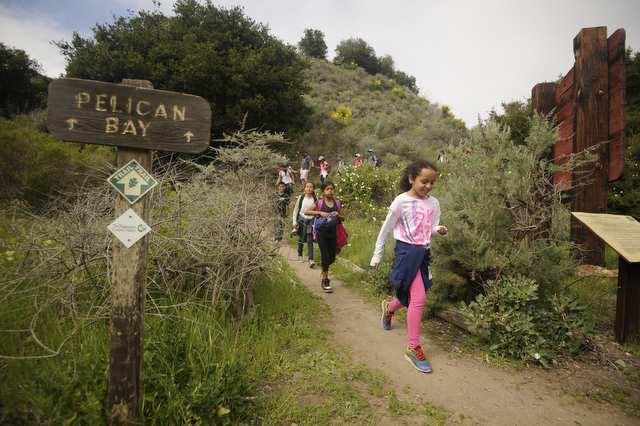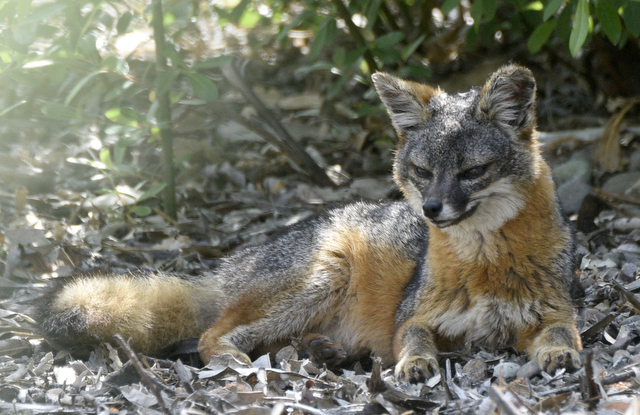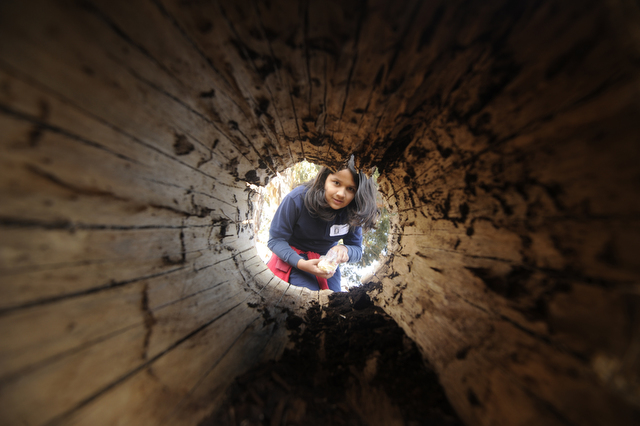Dignitaries, Fourth Graders Tour Santa Cruz Island
Praise Island Fox Recovery, Every Kid in a Park Initiative

Ninety Santa Paula fourth graders sailed to Santa Cruz Island Friday morning alongside Secretary of the Interior Sally Jewell and 24th District Congressional Representative Lois Capps. The two dignitaries flew in from D.C. to give yearlong national park passes to the Grace Thille Elementary School students as part of Every Kid in a Park, a presidential initiative to get children outdoors, and to praise island fox recovery efforts.
In the mid-1990s, Channel Islands National Park biologist Tim Coonan and his team first noticed a drop in the populations of three subspecies of island fox native to San Miguel, Santa Rosa, and Santa Cruz islands. Standing a foot tall and weighing three to 5 pounds, the grey fox relative was most likely brought from the mainland many years ago by Indians.
On developed Santa Catalina Island, where many people own dogs, a canine distemper disease killed 90 percent of island foxes in 1998. The same year, radio collars on San Miguel island foxes revealed they were being eaten by golden eagles, Coonan told The Independent in an interview. As opposed to native bald eagles — killed off by DDT in the 1960s — the nonnative birds preyed on foxes and feral pigs, mule deer, and elk, which were brought to the islands for farming and sport hunting.
By 1999, only 15 foxes lived on San Miguel and Santa Rosa, 55 on Santa Cruz, and 103 on Catalina. Island foxes were trapped in a “one-foot-in-the grave situation,” said Coonan. A team of 12 biologists, himself included, began a captive breeding program on the three northern islands. In 2004, four subspecies of island fox became federally endangered under the Endangered Species Act (ESA).

For about 10 years, 300 people worked to reintroduce about 60 bald eagles to the island and to relocate mule deer, 6,000 pigs, and 44 golden eagles to north of the Sierras, said Coonan. He attributes the fox’s record-fast revival to their rapid reproduction and the fact that no developments were threatened by island fox recovery. By 2008, the captive breeding program had “released over 250 foxes back into the three northern islands.” This month, two bald eagle chicks hatched on Santa Cruz.
Now, Coonan estimates 5,000-6,000 foxes thrive on the islands. “Once you solve things on an island, they tend to stay solved,” he added. About 2,500 foxes occupy Santa Cruz, where the U.S. Fish & Wildlife Service last month proposed the fox be removed from the endangered list, as well as on Santa Rosa and San Miguel.
The fastest ever recovery of a mammal under the ESA prompted Jewell and Capps to visit the Channel Islands. On Friday, the dignitaries handed each child a free national parks pass for themselves and their families. This year, grants by the National Park Foundation and Channel Islands Park Foundation will fund nearly 2,000 Ventura County fourth graders to tour the islands.

Next on Capps’ list is to provide families some financial assistance getting to the islands, she told Jewell on a tour of the Main Ranch. In her time left in office, Capps wants to end offshore drilling in federal waters of the Pacific. She asked Jewell whether President Barack Obama plans to finish studies on the environmental impact of fracking. “They will be done” by the end of May, said Jewell.
Some environmental groups have given fracking a bad name, said Jewell, but the process of extracting oil from rock can be done responsibly and with more disclosure from oil companies. “Fracking itself should not be a dirty word.” Speaking from experience as a petroleum engineer, she said, the key question is “How do you make sure in federal and tribal waters that your practices aren’t going to have [negative] consequences?”
Jewell, who described the plight of national parks as “death by 100 cuts,” wants more maintenance funding to go to the parks, which are virtually supported by philanthropy. “We could do much better,” she said, “if we invested” taxpayer money. The Secretary of the Interior compared the fiscal state of public lands to the financial woes plaguing BART and the D.C. Metro. The docks at Santa Cruz’s Scorpion Pier have been damaged, and we don’t have the resources to replace them.



